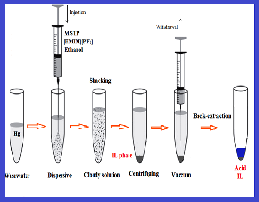Cloud point-dispersive liquid-liquid microextraction for preconcentration and determination of mercury in wastewater samples by methylsulfanyl thiophenol material
Volume 3, Issue 01, Pages 63-71, Mar 2020 *** Field: Analytical Chemistry
Abstract
A efficient method based on 4-methylsulfanyl thiophenol (MSTP, C7H8S2) and ionic liquid ([BMIM][PF6]) was used for mercury (Hg) separation and preconcentration from wastewater of petrochemical industries. The 0.01 mile molar of MSTP, 80 mg of [BMIM][PF6] was diluted with 0.2 mL of ethanol (ET 98%). The mixture was injected to 10 mL of wastewater samples, shacked by ultrasonic bath for 5.0 min and cloudy solution was achieved by ionic liquid micelles at pH=7.0. The mercury ions was complexed with MSTP and extracted on micelles (IL/ET) by cloud point dispersive liquid-liquid microextraction (CP-DLLME) at 50oC before determined by cold vapor atomic absorption spectrometry (CV-AAS). The favorite extraction for mercury with low LOD (15 ng L-1) and good linear rages (0.05- 6.2 μg L-1) was achieved (RSD<5%). The main parameters such as, pH, sample volumes, amount of MSTP, amount of IL and ultra-sonic time were optimized.
References
M. Tariq, Toxicity of mercury in human: a review, J. Clin. Toxicol., 9 (2019) 9-5.
V.A. Dixit, A simple model to solve a complex drug toxicity problem, Toxicol. Res., 8 (2018) 157-171.
R.A. Bernhoft, Mercury toxicity and treatment: a review of the literature, J. Environ. Public Health, 2012 (2012) 460508.
A.M. Attar, A. Kharkhaneh, M. Etemadifar, K. Keyhanian, V. Davoudi, M. Saadatnia, Serum mercury level and multiple sclerosis, Biol. Trace Elem. Res., 146 (2012) 150-153.
A. M. Al-Ghouti, D. Da’ana, M. Abu-Dieyeh, M. Khraisheh, Adsorptive removal of mercury from water by adsorbents derived from date pits, Sci. Reports, 9 (2019) 15327.
S.E. Schober, T.H. Sinks, R.L. Jones, P.M. Bolger, M. McDowell, J. Osterloh, E.S. Garrett, R.A. Canady, C.F. Dillon, Y. Sun, Blood mercury levels in US children and women of childbearing age, JAMA, 289 (2003) 1667-1674.
S. Santana Lins, C. Francisco Virgens, W. Nei Lopes dos Santos, I. Helena Santos Estev, On-line solid phase extraction system using an ion imprinted polymer based on dithizone chelating for selective preconcentration and determination of mercury in natural waters by CV AFS, Microchem. J., 150 (2019) 104075.
Y. Hui, Y. Liu, W C. Tang, Determination of mercury(II) on a centrifugal microfluidic device using ionic liquid dispersive liquid−liquid microextraction, Micromachin., 10 (2019) 523.
Y.M. Liu, F.P. Zhang, B.Y. Jiao, J.Y. Rao, G. Leng, Automated dispersive liquid-liquid microextraction coupled to high performance liquid chromatography-cold vapor atomic fluorescence spectroscopy for the determination of mercury species in natural water samples, J. Chromatogr., A 1493 (2017) 1–9.
M. Mei, X. Huang, X. Yang, Q. Luo, Effective extraction of triazines from environmental water samples using magnetismenhanced monolith-based in-tube solid phase microextraction, Anal. Chim. Acta, 937 (2016) 69–79.
I. López-García, Y. Vicente-Martínez, M. Hernández-Córdoba,Non-chromatographic speciation of chromium at sub-ppb levels using cloud point extraction in the presence of unmodified silver nanoparticles, Talanta, 132 (2015) 23-28.
M. Sajid, Dispersive liquid-liquid microextraction coupled with derivatization: A review of different modes, applications, and green aspects. TrAC Trends Anal. Chem., 106 (2018) 169–182.
M. Tuzen, O. Z. Pekiner, Ultrasound-assisted ionic liquid dispersive liquid-liquid microextraction combined with graphite furnace atomic absorption spectrometric for selenium speciation in foods and beverages, Food Chem., 188 (2015) 619–624.
H. Shirkhanloo, M. Ghazaghi, M. M. Eskandari, Cloud point assisted dispersive ionic liquid -liquid microextraction for chromium speciation in human blood samples based on isopropyl 2-[(isopropoxycarbothiolyl)disulfanyl] ethane thioate, Anal. Chem. Res., 10 (2016) 18-27.
L. Kocurov, I. S. Balogh, J. Sandrejov, V. Andruch, Recent advances in dispersive liquid-liquid microextraction using organic solvents lighter than water, A review, Microchem. J., 102 (2012) 11–17.
S.P.M. Ventura, F.A. E Silva, M.V. Quental, D. Mondal, M.G. Freire, J.A.P. Coutinho, Ionic-liquid-mediated extraction and separation processes for bioactive compounds: past, present, and future trends, Chem. Rev., 117 (2017) 6984–7052.
S. M. Mostafavi, M. Adibi, F. Pashaee, M. Piryaei, Modification of glassy carbon electrode by a simple, inexpensive and fast method using an ionic liquid based on immidazolium as working electrode in electrochemical determination of some biological compounds, Asian J. Chem., 23 (2011) 5247-5252.
S. M. Mostafavi, M. Adibi, F. Pashaee, M. Piryaei, Electrochemical Investigation of Thiophene on Glassy Carbon Electrode and Quantitative Determination of it in Simulated Oil Solution by Differential Pulse Voltammetry and Amperometry Techniques. Asian J. Chem., 23 (2011) 5356-5360.
H. Zheng, J. Hong, X. Luo, S. Li, M. Wang, Combination of sequential cloud point extraction and hydride generation atomic fluorescence spectrometry for preconcentration and determination of inorganic and methyl mercury in water samples, Microchem. J. 145 (2019) 806-812.
S.L.C. Ferreira,V.A. Lemos, L.O.B. Silva, A.F.S. Queiroz, A.S. Souza, E.G.P. da Silva, W.N.L. dos Santos, C.F. das Virgens, Analytical strategies of sample preparation for the determination of mercury in food matrices,A review, Microchem. J., 121 (2015) 227–236.
A. Badamchi Shabestari, M. Shekarchi, S. M. Mostafavi, Development of environmental analysis for determination of total mercury in fish oil pearls by microwave closed vessels digestion coupled with ICP-OES, Ekoloji, 27 (2018) 1935-1943.
S.M. Mostafavi, Mercury determination in work place air and human biological samples based on dispersive liquid-liquid micro-extraction coupled with cold vapor atomic absorption spectrometry, Anal. Method. Environ. Chem. J., 2 (2019) 49-58.
K. Seebunrueng, Y. Santaladchaiyakit, S. Srijaranai, Vortex-assisted low density solvent liquid-liquid microextraction and salt-induced demulsification coupled to high performance liquid chromatography for the determination of five organophosphorus pesticide residues in fruits, Talanta, 132 (2015) 769–774.
S. M. Mostafavi, A. A. Miranbeigi, Handbook of mineral analysis. Mani publication, Ltd, 2012.
G. D’Orazio, M. Asensio-Ramos, J. Hernandez-Borges, M. A. Rodrıguez-Delgado, S. Fanali, Evaluation of the combination of a dispersive liquid-liquid microextraction method with micellar electrokinetic chromatography coupled to mass spectrometry for the determination of estrogenic compounds in milk and yogurt, Electrophoresis, 36 (2015) 615–625.
K.D. Danov, P.A. Kralchevsky, K.P. Ananthapadmanabhan, Micelle-monomer equilibria in solutions of ionic surfactants and in ionic-nonionic mixtures: A generalized phase separation model, Adv. Colloid Interfac. Sci., 206 (2014) 17-45.
T.P. Nguyen, P. Hesemann, T.M.L. Tran, J.J.E. Moreau, Nanostructured polysilsesquioxanes bearing amine and ammonium groups by micelle templating using anionic surfactants, J. Mater. Chem. 20 (2010) 3910-3917.
JYuan, A. Li, T. Chen, J. Du, J. Pan, Micelle dominated distribution strategy for non-matrix matched calibration without an internal standard, Anal. Chim. Acta, 1102 (2019) 24-35.

Copyright (c) 2020 Analytical Methods in Environmental Chemistry Journal

This work is licensed under a Creative Commons Attribution 4.0 International License.
JOURNAL PUBLISHING AGREEMENT
PLEASE PROVIDE US THE FOLLOWING INFORMATION,
Article entitled:
Corresponding author:
To be published in the journal:
Your Status
I am the sole author of the manuscript
- I am an Iranian government employee.
- I am a European government employee
- I am a Asian government
- None of the above
I am one author signing on behalf of all co-authors of the manuscript
- I am an Iranian government employee.
- I am a European government employee
- I am a Asian government
- None of the above
Please tick the above blanks (as appropriate), review the Journal Publishing Agreement, and then sign and date the document in black ink.
Published Journal Article: the author may share a link to the formal publication through the relevant DOI. Additionally theses and dissertations which contain embedded Published Journal Articles as part of the formal submission may be hosted publicly by the awarding institution with a link to the formal publication through the relevant DOI. Any other sharing of Published Journal Articles is by agreement with the publisher only.
Signed: ______________________________________ Name printed: ___________________________________________
Title and Company (if employer representative): _______________________Date: __________________________________














